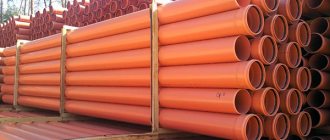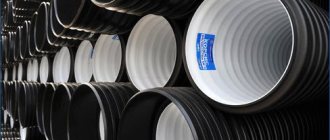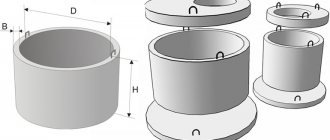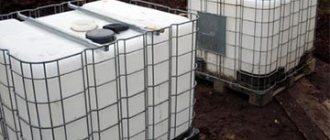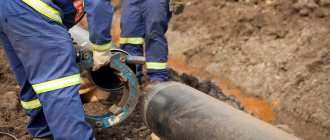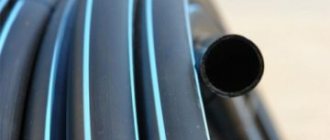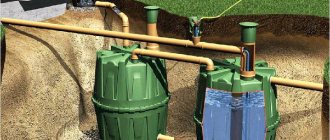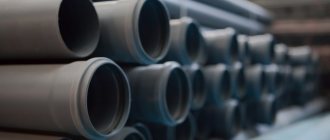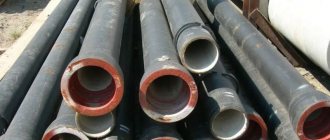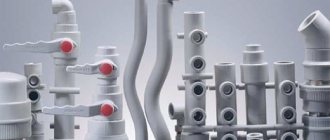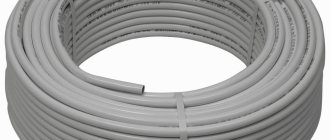Correctly selected dimensions of metal-plastic pipes are important when installing a water supply system and connecting with fittings. If the parts are poorly combined during the installation process, an emergency situation occurs, which leads not only to breakdown and depressurization of the product itself, but also to failure of the entire system.
Metal-plastic pipes connected by fists.
Composition of metal-plastic pipes
The metal-plastic pipeline has a complex structure. The pipe contains 5 layers. The inner layer is made of cross-linked, extruded high-density polyethylene material, which provides greater flexibility and resistance to scale formation when used in hot systems. The outer plastic shell is supplemented with chemical additives to increase durability, protects the product from any negative influences and increases service life.
Between the 2 layers there is an aluminum reinforcing layer, which is a foil with adhesive glue applied on both sides, which fixes the intermediate part.
The aluminum layer is made by laser butt or ultrasonic lap welding. In practice, overlapping joints have uneven geometric parameters and, as a result, lower strength. The laser-made pipeline does not contain seams and has a uniform thickness along its entire length.
The main purpose of the aluminum layer is to form a diffusion barrier that prevents the penetration of oxygen and water vapor into the product from the external environment. It does not affect operating parameters such as heating and operating pressure. Water flows not through an aluminum pipe, but through a plastic one, so the properties of cross-linked polyethylene are more important during the work process. In addition, the aluminum layer partially compensates for the thermal expansion of the water supply system and protects it from delamination as a result of intra-pipe stress.
Cross-section of a metal-plastic pipe.
Permitted temperature and pressure values.
Metal-plastic products can withstand pressure and temperature equal to:
1. The working temperature is considered to be a minimum of 0 degrees, a maximum of 95 degrees, and the working pressure is considered to be no higher than ten bar. When the pressure increases to twenty-five bar, the critical temperature of the liquid is considered to be twenty-five degrees.
2. When the system operates at maximum temperatures, the pressure should not exceed ten bars.
3. if the tightness of the network is broken, then at twenty degrees of liquid, the pressure will increase to a value of ninety-four bars.
Characteristics of metal-plastic pipes
The main characteristics of polymer and aluminum pipes include:
- Inner diameter. Necessary for connection with fittings and other components. Characterizes the throughput of the pipe.
- Outer radius. They pay attention to it when taking measurements and purchasing a product. Indicators vary between 16-63 mm.
- Layer thickness. It is selected taking into account the cross-section and can be 2-3.5 mm.
Additional characteristics:
- Bend radius. It has different sizes: from 80 mm with an outer section of 16 mm to 550 mm with a diameter of 40 mm. Data is given for manual pipe bending. When using a pipe bender, the radius may be larger.
- The amount of liquid per 1 running meter is determined in liters and depends on the characteristics of the product.
Kinds
Depending on the type of material used to reinforce thermoplastics, composite pipes are:
- Reinforced with aluminum foil.
- Reinforced with metal mesh.
A foil-based product is more flexible and therefore most convenient for use in private construction. A rigid mesh frame increases strength but reduces flexibility, so it is more profitable to use such pipes when laying straight sections of highways.
Table of characteristics of metal-plastic pipes
Technical and operational characteristics are presented in the table:
| Indicators | External section, mm | ||||||||||
| 16 | 20 | 26 | 32 | 40 | |||||||
| Pipe internal diameter, mm | 12 | 16 | 20 | 26 | 33 | ||||||
| Width of the forming layer, mm | 2 | 2 | 3 | 3 | 3,5 | ||||||
| Weight of the product per 1 linear meter, in grams | 115 | 170 | 300 | 370 | 430 | ||||||
| Volume of water in 1 lm, in liters | 0,113 | 0,201 | 0,314 | 0,531 | 0,855 | ||||||
| Operational heating at 10 atm. | +0…95°С | ||||||||||
| At 25 atm. | +0…25°С | ||||||||||
| Maximum permissible temperature | +130°С | ||||||||||
| Highest pressure at maximum heating, in atmospheres | 10 | ||||||||||
| Breaking pressure at 20°C, in bars | 94 | 87 | 88 | 74 | 67 | ||||||
| Linear expansion, 1/°С | 0.26x0.0001 | ||||||||||
| Smoothness index | 0,07 | ||||||||||
| Thermal insulation, W/m*K | 0,43 | ||||||||||
| Strength of sizing, N/10 mm | 70 | ||||||||||
| Aluminum welding strength, N/mm² | 57 | ||||||||||
| Resistance in the absence of deformation, when p=const and the condition is met | |||||||||||
| +20°С for 60 minutes, MPa | 5,71 | 5,1 | 5,43 | 5,12 | 4,84 | ||||||
| +95°С for 60 minutes, MPa | 3,3 | 3,03 | 3,18 | 3,03 | 2,95 | ||||||
| +95°С at 100 hours, MPa | 2,93 | 2,69 | 2,83 | 2,7 | 2,62 | ||||||
| +95°С for 1000 hours, MPa | 2,57 | 2,36 | 2,52 | 2,44 | 2,31 | ||||||
| Resistance to transverse tearing, N | 2880 | 3050 | 3260 | 3430 | 3570 | ||||||
| Service life, years | 50 | ||||||||||
Reviews
| Review of reviews on composite pipes | |
| Positive | Negative |
| Convenient, quick installation | Deformation due to excessively high temperatures |
| Practical and inexpensive | Connections weaken over time |
| Allows you to hide wiring in the wall | Undesirability of hidden installation of pipes for water supply and heating in walls |
| No rust | |
| Aesthetics, easy care | |
Dimensions of metal-plastic pipes
General standardization represents 6 standard sizes of pipes for water supply: 16, 20, 26, 32, 40 and 48 mm. The domestic market also offers pipe products with an outer diameter of 63 mm, but they are rarely used. For water supply, products of 16 and 20 mm are used, and for sewer pipes - 40 and 48 mm.
Metal-plastic pipes of different diameters.
Each value corresponds to an internal diameter: 12, 16, 20, 26, 32 and 40 mm. In addition to the metric dimension, in practice plumbers use measurements in inches. The ratio of the metric system to the inch system can be represented as follows:
- 16 mm - 1/2";
- 20 mm - 3/4";
- 26 mm - 1";
- 32 mm - 1 and 1/4";
- 40 mm - 1 and 1/2";
- 48 mm - 2".
16-12
A 16 by 12 metal-plastic pipe is a pipe with an outer cross-section of 16 mm, an internal cross-section of 12 mm, a product thickness of 2 mm, aluminum - 0.2 mm. They are most common in the construction of cold and hot water supply systems in private homes. They are installed on meters or for supplying liquid to mixing devices. In apartments, plumbers use 16x12 pipes to install water pipes in the kitchen or bathroom.
Despite their small cross-sections, they do not silt, grease and impurities do not stick, have better strength properties and can withstand the greatest loads. Their cost is cheaper than larger products, and the throughput is practically the same. Sold in coils. Their length can range from 50 to 200 m. A sample of 1 running meter weighs 115 g.
20-16
Metal-plastic pipes of standard size 20x16 have a cross-section of 20 mm on the outside, 16 mm on the inside, the thickness of the product is 2 mm, like the 16th model, the thickness of the foil is 0.25 mm. They are most suitable for basic water distribution in houses and apartments; for additional equipment, a cheaper 16 mm pipe is selected. Polymers are used to install heated floors when there is low water pressure or a long pipeline structure.
The disadvantage of the products is the high cost of fittings for fastening parts during installation.
26-20
The following dimensions are typical for 26x20 aluminum and polymer pipes:
- external and internal diameters - 26 and 20 mm;
- The width of the forming layer is 3 mm.
They are mounted in the form of risers and distribution of heated floors. In individual communication systems of private houses, due to constant pressure drops, pipes of 26 mm are installed.
32-26
The products are used in places where a large volume of water is required, as they have high throughput. The liquid moves through the system evenly and quickly and is supplied to the consumer uninterruptedly.
A pipe with a 3 mm sheath is suitable for main water lines and volumetric distribution, as well as a riser for connecting pipeline elements and ensuring normal coolant circulation in heating devices.
40-32
Polyethylene pipes are popular in the construction and plumbing markets. They are used in central heating systems, water supply, ventilation, when installing high-voltage lines for insulation, and are placed in the most inaccessible places. They are durable and can be used without additional repairs and maintenance.
The products can transport any liquid and withstand the aggressive effects of various chemicals, therefore they are well suited for sewage. The inside of the pipe is 32 mm, the outside is 40 mm, the wall is 3.5 mm. The weight of 1 linear meter of the sample is 430 g, the volume of liquid is 0.855 l.
50-40
According to the standard, the outer cross-section of the pipe is 48 mm; when implemented, the value is 50 mm. The internal dimension is 40 mm and the thickness is 4 mm. Metal-plastic products freely pass a large volume of any liquid and are suitable for industrial communications.
Due to their excellent performance characteristics, they can transport hazardous liquids and gases under high pressure, which is why they are installed at special industrial facilities, despite some restrictions on their use.
Recommendations
High-quality pipes made of metal-plastic cannot be cheap (the average price on the market for 1 meter is ~ 30 rubles).
By saving on the material of the pipeline system, you risk purchasing a fake and encountering a number of breakdowns and leaks. A few simple tips will help ensure the durability and uninterrupted operation of any utility network.
Plumber tips:
- Before purchasing material for a future metal-plastic water supply system, determine the dimensions in advance (the internal diameter is indicated by DU on the packaging).
- To avoid clogging and foreign objects entering the system, when installing plastic sections, restrictive filters are used;
- To facilitate and speed up the installation process when laying metal-plastic pipes, use a pressing wrench.
Selection of metal-plastic products
To make the right choice when purchasing metal-plastic pipes, you need to understand the purposes for which they are needed. Then, based on the purpose, product parameters are selected. These include:
- wall thickness;
- internal permeability and external radius;
- the weight of the pipe in accordance with the weight of the entire water supply system;
- minimum and maximum heating rates;
- maximum bending radius;
- life time.
All parameters are standardized; if there are deviations from the norm, they are small. Wall thickness is important. The installation of the pipeline depends on it. The fitting and shut-off valves are selected taking into account the thickness, especially when replacing old metal pipes with new, metal-plastic ones.
When choosing, it is worth considering the method of connecting the foil layer in the structure. It is indicated on the product labeling. More durable and resistant pipes are made using seamless butt welding. The thickness of the layer should not exceed the standard of 0.3-0.6 mm. The outer and inner shell material is cross-linked or heat-resistant polyethylene such as PERT or PEX. If the product is made from other raw materials, this will affect the further operation of the system. Upon visual inspection, the pipes should be intact. Cracks and delaminations are not acceptable.
High-quality products are certified and comply with international and domestic standards, so when purchasing, you need to find out whether the product has a certificate from the Scientific Research Institute of Plumbing.
It is better to purchase metal-plastic pipes from a reputable manufacturer. Different countries are engaged in the production of polyethylene products, among them Russia, Italy and Germany stand out. You can pay attention to pipes of the domestic brand “Nanoplast”, the Italian company Valtec or the German company Oventrop. The products are made of the highest quality material, the foil is made of pure aluminum.
To make the right choice, the buyer needs to familiarize himself with the markings that are applied with indelible paint to the pipe in accordance with accepted international rules. It may differ from one manufacturer to another, but most often it has a general appearance. The markings indicate:
- Manufacturer.
- Pipe name or certificate of conformity.
- Material type.
- Stitching method.
- Standard size ratio.
- Nominal sizes.
- Nominal pressure.
- Production standards (date of manufacture, batch number).
If questions arise when choosing pipes, you can contact a consultant for help in specialized stores.
Production process
The production of metal-plastic (multilayer) pipes is carried out on special automated industrial-type flow complexes. Moreover, during the manufacturing process, not only the products are formed, but also they are computer checked for compliance with quality standards.
- First of all, a metal base (frame) is formed from aluminum foil.
- Then the aluminum billet is sent to the compartment, where its edges are joined using ultrasonic welding.
- By injecting air into the resulting pipe (under a pressure of 4-6 atmospheres), the strength of the weld is controlled.
- After checking, the workpiece enters the extruder, where an adhesive and polymer layer is gradually applied. First, the inner surface of the aluminum billet is processed, then the outer surface. At the same stage, a marking strip - blue or red - is applied to the product.
- At the final stage, the product is cooled: first with air, then in a water bath.
- At the exit, the pipe goes to the so-called quality control department, where the “scanning” and measurement of the geometry of the layers takes place.
- Finally, the product is labeled and wound into coils.
Table of standard parameters of metal-plastic products
Standards for pipes are described in the table:
| External section, mm | Diameter value of external thread, in inches | Pipe diameter, mm | Thickness of the entire layer, mm |
| 16 | 1/2 | 12 | 2 |
| 20 | 3/4 | 16 | 2 |
| 26 | 1 | 20 | 3 |
| 32 | 1 and 1/4 | 26 | 3 |
| 40 | 1 and 1/2 | 32 | 3,9 |
| 48 | 2 | 40 | 4 |
The best manufacturers
| № | Manufacturer | Brand | Manufacturer country |
| 1 | Rehau | Rehau | Germany |
| 2 | Kermi | Kermi | Germany |
| 3 | Oventrop | Oventrop | Germany |
| 4 | Uponor | Uponor | Finland |
| 5 | HENCO | HENCO | Belgium |
| 6 | VALTEC | VALTEC | Italy |
| 7 | Unidelta | Deltall-ISO | Italy |
| 8 | Valsir | Pexal | Italy |
| 9 | Valtec | Valtec | Italy/Russia |
| 10 | MPT-Plastik R | Liral | Russia |
| 11 | Nefteprom | Altais | Russia |
| 12 | HydroSta | HydroSta | South Korea |
Table of bending radius of metal-plastic pipes (minimum value)
| Pipe outer diameter, mm | 16 | 20 | 26 | 32 | 40 |
| Minimum bending radius using manual method, mm | 80 | 100 | 110 | 160 | 550 |
| Radius of curvature using a pipe bender, mm | 45 | 60 | 95 | 125 | 180 |
How to determine bend radius.
If you bend a product at home without knowing its characteristics, you can damage the pipe and break its integrity when heated, so you need to use a standard table to determine the parameters or calculate the radius yourself.
Restrictions on use
However, it should be taken into account that the limited technical characteristics of metal-plastic pipelines also impose some restrictions on their use. This is how they cannot be used:
- In heating circuits or DHW systems with a working environment temperature above 110⁰С.
- In close proximity to sources of thermal radiation when they are heated above 150⁰C.
- In heating systems equipped with an elevator unit.
- For the installation of safety, signal, expansion or overflow lines;
- As chimneys.
- For the installation of fire protection circuits, as well as in buildings of low fire safety category (class G).
Cutter
It is recommended for use in small and medium volume systems.
A knife made of especially strong hardened steel was mounted into the device. The cutters are equipped with long handles and a lever ratchet mechanism that allows for cutting. These devices allow you to work with tubular products with a volume of up to 63 mm.
Valtec is rightfully considered the best manufacturer of cutters. This brand is known not only for high-quality cutters for metal-plastic products, but also for joining parts, compression equipment and many other installation accessories.
Another “whale” of manufacturing is the “Rothenberger” brand. All products of this company are not inferior to the previous manufacturer in terms of reliability.
Cutting accessories
The metal-plastic system has a high degree of flexibility. Manufacturers supply these products in coils, where the length is two, three, five or more meters. For these reasons, it is necessary to determine the required length of the pipeline and prepare pipe sections of the required size.
Often an ordinary hacksaw is used for this work, but it can deform the cross-section of the pipe, leaving behind burrs. Professional craftsmen recommend cutting with the following tools:
Crimping pliers
Crimping pliers are used to join the lines of the line with the installation of press fittings. Such installation can only be carried out efficiently using this tool. The result is a durable and reliable joint that will not require burdensome further maintenance, because such units cannot be disassembled.
There are different types of ticks:
- Manual. Hydraulic. Electromechanical.
Hand-held devices are suitable for household needs.
Calibrator
During cuts, the cross-section of the rolled pipe assortment may change.
You can give it its previous shape using a tool such as a calibrator. It not only helps return the cut to a round shape, but also removes the chamfer on the inside. This tool is inserted into the pipe and turned a couple of times.
For the calibrator to work properly, the workpiece must be cut at an angle of 90 degrees. The calibrator fitting must be inserted exactly along the axis, and the pipe must be advanced until the knives rest against the inner layer.
This processing of the assortment is necessary when preparing it for joining. After two hundred operations performed, the knives on the device need to be sharpened; for this, a needle file or ordinary sandpaper is used.
The best products in this line for installation are those from Italian manufacturers.
IMPORTANT! When purchasing any of the tools for cutting pipe assortments, you must strictly adhere to the recommendations given by the manufacturers regarding the volume of products to be processed. Also, devices must be placed correctly relative to the cut line.
